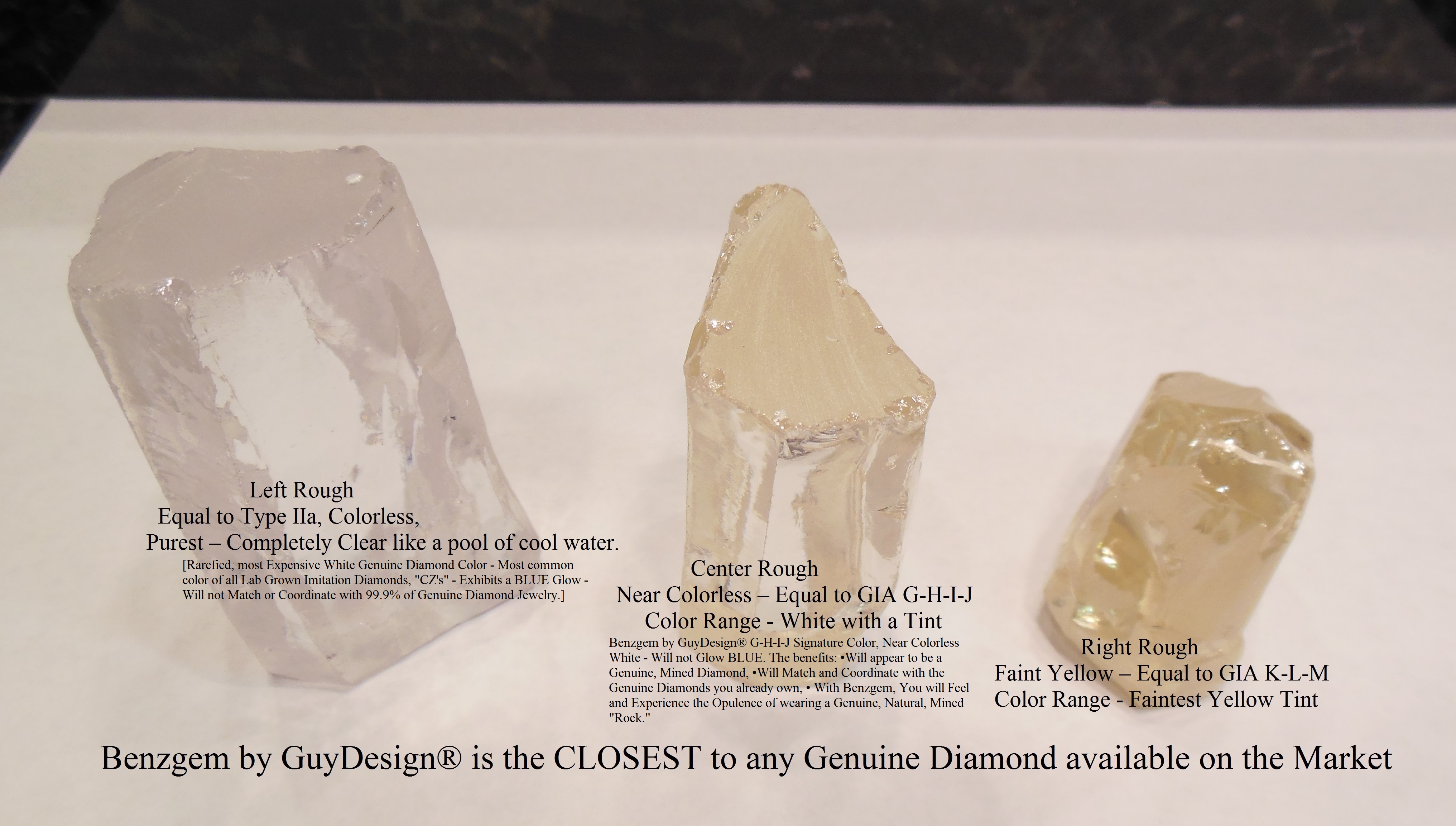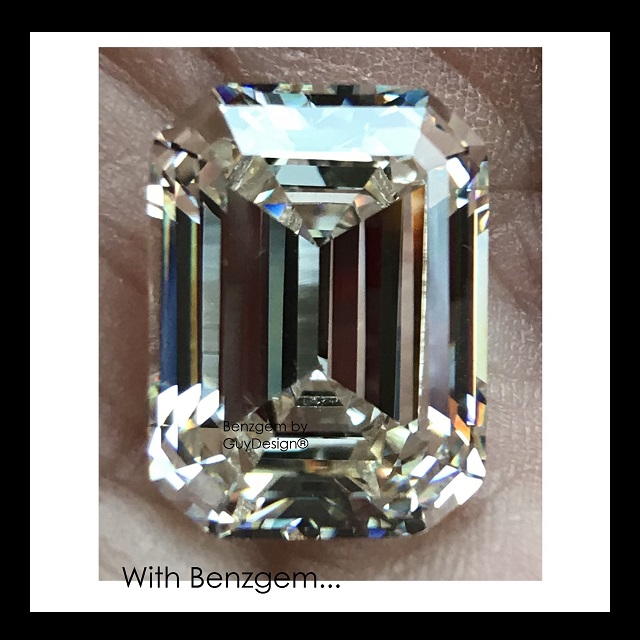What is the difference between a Natural Gem, a Synthetic Gem and an Artificial Gem?
Posted by Guy Michael Smith on 23rd Mar 2020
Everything you need to Know about purchasing a beautiful Diamond, Gemstone or Imitation.
What exactly is the difference between a Natural Gem, a Synthetic Gem and an Artificial Gem you ask?
With the recent advent of Lab-Grown Real Carbon Diamonds being sold in the marketplace, there is plenty of Misinformation and Misuse of Terminology that is meant to Confuse those Consumers trying to understand the differences between various kinds of Jewelry Stones and Products.
In this Article We will cover the Following Items:
- The 3 types of Jewelry Stones.
- An explanation of each type.
- Recommendations.
- Federal Trade Commission Ruling, August 2018
- How to protect yourself from being duped out of your money.

[Stunningly Beautiful Benzgem Alternative to Diamond. This Photo was taken in the palm of my hand in the Eastern Morning Light.]
Let's begin with the Basics:
There are three kinds of Jewelry Stones:
- Natural, Mined Diamonds, Precious and Semi-Precious Gemstones.
- Man-Made Synthetic Diamonds, Precious and Semi-Precious Gemstones.
- Man-Made Artificial Diamonds, Artificial Gemstones.
Further Explanation of each kind of Jewelry Stone:
1. Jewelry stones that are made by Mother Nature, are Mined from the ground in their Natural form are appropriately described as:
- Mined Diamonds or Mined Precious, Semi-Precious Gemstone.
- Mined Real Diamond or Mined Real Precious, Semi-Precious Gemstone.
- Mined Genuine Diamond or Mined Genuine Precious, Semi-Precious Gemstone.
2. Synthetically produced Jewelry stones. Jewelry Stones produced in a Laboratory.
Let me explain. Jewelry stones not made by Mother Nature, but instead, they are made by man, using Mother Nature's elements and Minerals and produced in a laboratory environment. These Elements and Minerals are the same Mother Nature used to create the Mined from the ground Diamond or Gemstone. These man made Diamonds and gems are:
- Chemically, physically and optically identical as the Mined from the Ground Diamond or Gemstone.
Synthetic gems have the same hardness. They handle light the same; they sparkle the same and have the same colors available as the Mined from the ground Gemstone.
The main difference between the Mined from the ground gem and the Lab-Grown gem, is their cost - they are less expensive. Their Purity [clarity] - they are internally cleaner, and their saturation of color is more uniform and consistent than the Mined from the ground gem.
In this life, quality is directly related to the price you pay for any given item. Although a synthetic gem is relatively inexpensive compared to the Mined, natural gem counterpart, Fine Quality cutting will contribute most to the beauty of the synthetic Diamond or Gemstone.
Mining is a costly endeavor, and Precise gemstone cutting is not inexpensive. The Best Quality Cut will contribute, most significantly, to the overall Value and Beauty of a finished gem, whether the Jewel is Lab-Created or Mined from the ground.
Today, Diamonds and Gemstones of all kinds are Synthetically produced and available for sale.
The most recent development in how Synthetic Diamonds and Gemstones are sold and Marketed to Consumers, is covered by a Federal Trade Commission ruling taking place in August of 2018.
The FTC Stated:
Lab-Grown Synthetically produced, Diamonds, and Gemstones can be Properly described as Real and Genuine, as they are essentially the same optically, physically and chemically. However, they must be Clear and Conspicuously disclosed to the consumer that they are Man Made, and in the following terms:
- Man Made, Synthetic Diamond, Man Made, Synthetic Gem [Rubies, Sapphire, Emerald... Fill in the blank, as there are many varieties, both Precious and Semi-Precious.]
- Lab Grown Diamond, Lab Grown [Rubies, Sapphires, etc.. Many Gemstones as mentioned before]
- Lab Created Diamond, Lab Created Gemstones [both Precious and Semi-Precious]
- Cultured Diamond, Cultured Gemstones.
Synthetic and Artificial explained in Very simple terms using a common Food Supplement and Sweetener example:
Example #1
Let us look at the B 12 Vitamin. It is available Natural or chemically synthesized in a laboratory under controlled conditions. B 12 vitamin is not considered artificial as it is Chemically, Analytically, and Functionally indistinguishable from the naturally isolated B12 vitamin. Still, it is not natural either (obtained from Nature); it is synthetic. Although produced in a lab, it is still B12 Vitamin.
. [Remember other words meaning the same as Artificial is, Imitation, Simulated, Fake, Faux, and so forth]
Example #2
Artificial sweetener. You know the stuff, the Pink and Blue packets some of us use to sweeten our coffee and tea. It is referred to as Artificial as It has nothing to do with Real, Natural, Grown in the Ground, Sugar Cane. The white stuff we know as sugar is sucrose, a molecule composed of 12 atoms of carbon, 22 atoms of hydrogen, and 11 atoms of oxygen (C 12H22O11). The Pink and Blue packet sweeteners are not Sugar, and as such, could not be marketed as Sugar. They can be sold legally as a Sugar substitute or as an Alternative to Sugar.

The 3rd kind of Jewelry Stone is an Artificial Gemstone:
3. Artificial jewelry stones are mass-produced in various materials to look like Diamond and other Precious & Semi-Precious Gemstones and Pearls. Misrepresentation occurs pretty often with these Jewelry Stones often advertised as;
- Man-Made Diamonds, Man Made Rubies, Sapphires, ETC...
These jewelry stones should be appropriately described as: Artificial ________, Fake ________, Faux ________, Imitation ________, Simulation ________, Simulated ________, CZ, Cubic Zirconia, Russian Brilliants, Moissanite, and the list continues with all sorts of Name Branded Imitations. Just fill in the blank.
Crucial info:
Because CZ and Moissanite have initially been discovered naturally in the Environment, in small quantities, these two diamond imitations are man-made synthetically. These are, however, not Synthetic Diamonds or Synthetic gemstones in the sense of being Real or Genuine.
- They are, Synthetically produced Cubic Zirconia and Synthetically created Moissanite.
- Two jewelry stones mass-produced for the sole purpose of imitating a real diamond.
In the right color and Cut, CZ has the potential to look real because it is singly refractive.
Moissanite, on the other hand, is doubly refractive [has a blurred, ultra colorful brilliance] and, as such, has not the ability to look like a Real, Genuine, Singly refractive Diamond. It has plenty of sparkles; however, its Faceting patterns are different from a Real Diamond; therefore, it does not look like a diamond.
Three Photos of Moissanite Imitation Diamond. Notice the heavy Double Fraction in the middle photo. The crisp Airy look and Transparency of the Singly Refractive Diamond and CZ is not to be found in Moissanite Imitations.



An 11 millimeter [5 carat Diamond Equivalent] Moissanite Solitaire mounted in a Classic Tiffany Setting.
How does the Consumer weed through Misinformation and find the Truth?
- The best way to weed out a disreputable Website, as well as the Bricks and Mortar establishment, is to know the Mineral Name given to the gemstone of which you are inquiring... For Example, 1. Alexandrite - Mineral Name, Chrysoberyl... 2. Emerald and Aquamarine - Mineral Name, Beryl... Do you get the Idea? 3. Sapphire [All Colors including Color Change Sapphire] and Ruby - Mineral Name, Corundum
- Know about what for which you are honestly asking. Let me give this example. Once you know that pretty Blue "Sapphire," is not made of Corundum [Mineral Name] but rather is a "Sapphire Blue" CZ, You are less likely to get duped out of your money.
- Always ask questions of the seller, but know what to ask.
- Don't Presume anything.
Contacting the Better Business Bureau may help find out complaints against an establishment. The Bureau will not answer questions you need answering about a product.
For instance, you are interested in a "Lab-Grown, Man Made, Real Diamond," you would ask the seller,
- "Is this stone a 100% carbon Diamond"?
- The seller may answer "Yes it is" or may answer "Its a Diamond Coated" or "a 50% Diamond Coated".
- You will then have to press further with "Is it a coated CZ or a coated Moissanite." If your intention is for a carbon diamond, nothing else will do than A Mined Diamond or a Lab Grown Diamond.
I will caution you that any coating added to a CZ or a Moissanite is entirely useless.
- The coating will not change the structure or the brilliance of the Jewelry Stone.
- To coat a Moissanite, for instance, will not remove its double refractive attribute [Remember, Real Diamonds and CZ are both singly refractive].
- It is, therefore, a waste of money and entirely useless to coat a Moissanite.
A coating could help, however, dumb down the color of a commercial White CZ [Remember 99.99% of Czs are Ultra White.. 2 shades whiter than a D Color Mined Diamond. Plus, it Fluorescence "Glows" pale blue. All these attributes contribute to CZs Artificial Look].
- A coating may or may not help with scratching, as the coating "is so thin" that it can only be as strong as the substrate to which it is applied.
- Cubic Zirconia is already as Hard as an Emerald, a Garnet, or an Alexandrite. If you are that rough on a Gem, you'd better stick with Real Diamond, Mined from the Ground, or the newest Lab-Created 100% Carbon Diamond.
Coating for color is also a moot point as there is, in fact, a CZ Imitation Diamond that exists. And it's Rough material is already the color of most Real Diamonds, G-H-I-J color range Diamonds. This Imitation Diamond has no Fluorescence, and it looks Realistic, Believable, and Natural, It is called BENZGEM. It is the Best Imitation Diamond in the World.
Benzgem is the certified Best Imitation Diamond ever created and is the CLOSEST to any Natural Mined Diamond available on the Market. The combination of Rough Body Color, its Diamond Quality Cut and Clarity make it compatible with the natural mined diamond jewelry you already own.

- Left Rough - Equal to Type IIa Mined Diamond, Colorless, Purest – Completely Clear like a pool of cool water.
- Center Rough, Benzgem, is the most Believable and Realistic - Near Colorless, White – Equal to GIA G-H-I-J Mined Diamond Color Range.
- Right Rough - Faint Yellow – Equal to GIA K-L-M Mined Diamond Color Range.

Benzgem by GuyDesign® - Best Diamond Copy in the World

Dear Consumer,
I sincerely hope this information answers any questions you may have about what is Real and what is Fake in terms of Jewelry Stones.
Should you have any comments or questions about what you have read in this article, I would love to hear from you.
Happy Shopping,
Guy Michael Smith
